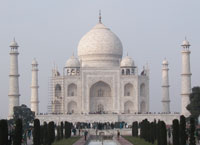 |
| Home Send Money to India Modes of money transfer India BPO India Tourism Taj Mahal Kumarakom Lakes Jaipur Pink city Alappuzha Backwaters Goa Tourism Munnar Hill Station India States Andhra Pradesh Assam Bihar Chattisgarh Goa Gujarat Haryana Himachal Pradesh Jammu and Kashmir Jharkhand Karnataka Kerala Madhya Pradesh Maharashtra Manipur Meghalaya Mizoram Nagaland Punjab Rajasthan Sikkim Tamil Nadu Orissa Tripura Uttar Pradesh Uttaranchal West Bengal India Quick Links Indiaweblinks World Wonders Web 123 Biotech Honeymoon Packages |
India States - Rajasthan  Rajasthan is the largest state of the Republic of India in terms of area. It borders Pakistan to the west, Gujarat to the southwest, Madhya Pradesh to the southeast, Uttar Pradesh and Haryana to the northeast and Punjab to the north. state capital is Jaipur. Geographical features include the Thar Desert in western Rajasthan and the termination of the Ghaggar River. One of the world's oldest mountain ranges, the Aravalli Range, cradles the only hill station of Rajasthan, Mount Abu, and its world famous Dilwara Temples. Eastern Rajasthan has two national tiger reserves, Ranthambore and Sariska, as well as Keoladeo National Park near Bharatpur, famous for its bird life.
Rajasthan is the largest state of the Republic of India in terms of area. It borders Pakistan to the west, Gujarat to the southwest, Madhya Pradesh to the southeast, Uttar Pradesh and Haryana to the northeast and Punjab to the north. state capital is Jaipur. Geographical features include the Thar Desert in western Rajasthan and the termination of the Ghaggar River. One of the world's oldest mountain ranges, the Aravalli Range, cradles the only hill station of Rajasthan, Mount Abu, and its world famous Dilwara Temples. Eastern Rajasthan has two national tiger reserves, Ranthambore and Sariska, as well as Keoladeo National Park near Bharatpur, famous for its bird life.
Travelling on the famed Palace on Wheels is one of the most memorable ways to explore India's stately splendour. Unquestionably it's an unparalleled experience to ride the replica carriages refurbished to look like the original saloons of the Maharajas, the erstwhile rulers of India. The Palace on Wheels is one of India's most fascinating sojourns covering the pink state capital Jaipur, the golden citadel Jaisalmer, the blue city of Jodhpur, the National Park Ramthambhor, the symbol of chivalry Chittorgarh, romantic city of Lakes Udaipur, the bird sanctuary Bharatpur and the mughal capital Agra before returning to Delhi. Endowed with natural beauty and a great history ,tourism is going great guns in Rajasthan.The palaces of Jaipur, lakes of Udaipur and desert forts of Jaisalmer are among the most preferred destination of many a tourist ,Indian or foreign.Tourism accounts for eight percent of the state's domestic product.Many old and neglected palaces and forts have been converted into heritage hotels.Tourism has increased employment in hospitality sector.
Rajasthan was earlier called Rajputana (state of Rajputs) after the ruling class of Rajputs. Rajput which literally means 'son of rulers'. Rajput clans rose to prominence in the 6th century, establishing kingdoms in Rajasthan and across northern India. The Rajputs resisted Muslim incursions into India, although a number of Rajput states became tributaries to the Delhi Sultanate and Mughal Empire during those empires' peak of expansion. As these empires weakened, the Rajputs reasserted their independence. With the decline of the Mughal Empire in the 18th century, Rajputana become more and more independant.The Rajput kings concluded treaties with the British in the early 19th century, accepting British sovereignty
Economy
 Jaipur also popularly known as the Pink City, historically sometimes rendered as Jeypore, is the capital of Rajasthan state, India. Jaipur is also the capital of Jaipur District. Jaipur is the former capital of a princely state of the same name. The city was built of pink stucco in imitation of sandstone, and is remarkable among pre-modern Indian cities for the width and regularity of its streets. The city is laid out into six quarters, separated by broad streets 111 ft wide. The urban quarters are further divided by networks of gridded streets. Five quarters wrap around the east, south, and west sides of a central palace quarter, with a sixth quarter immediately to the east. The Palace quarter encloses a sprawling palace complex, formal gardens, and a small lake. A fort crowns the hill in the northwest corner of the old city. Another noteworthy building is Jai Singh's observatory, Jantar Mantar. Jaipur, with its rich and colourful past, resplendent with tales of valour and bravery is now one of the most important heritage cities in India, and is a must-see for tourists coming to India. Jaipur is considered by many urbanists to be one of the best planned cities. In the 19th century the city grew rapidly and became prosperous, with a population of 160,000 in 1900, and the city's wide boulevards were paved and lit with gas. Its chief industries were in metals and marble, which are fostered by a school of art, founded in 1868. There was also a wealthy and enterprising community of native bankers. The city had three colleges and several hospitals.
Jaipur also popularly known as the Pink City, historically sometimes rendered as Jeypore, is the capital of Rajasthan state, India. Jaipur is also the capital of Jaipur District. Jaipur is the former capital of a princely state of the same name. The city was built of pink stucco in imitation of sandstone, and is remarkable among pre-modern Indian cities for the width and regularity of its streets. The city is laid out into six quarters, separated by broad streets 111 ft wide. The urban quarters are further divided by networks of gridded streets. Five quarters wrap around the east, south, and west sides of a central palace quarter, with a sixth quarter immediately to the east. The Palace quarter encloses a sprawling palace complex, formal gardens, and a small lake. A fort crowns the hill in the northwest corner of the old city. Another noteworthy building is Jai Singh's observatory, Jantar Mantar. Jaipur, with its rich and colourful past, resplendent with tales of valour and bravery is now one of the most important heritage cities in India, and is a must-see for tourists coming to India. Jaipur is considered by many urbanists to be one of the best planned cities. In the 19th century the city grew rapidly and became prosperous, with a population of 160,000 in 1900, and the city's wide boulevards were paved and lit with gas. Its chief industries were in metals and marble, which are fostered by a school of art, founded in 1868. There was also a wealthy and enterprising community of native bankers. The city had three colleges and several hospitals.
|
|
|
|

